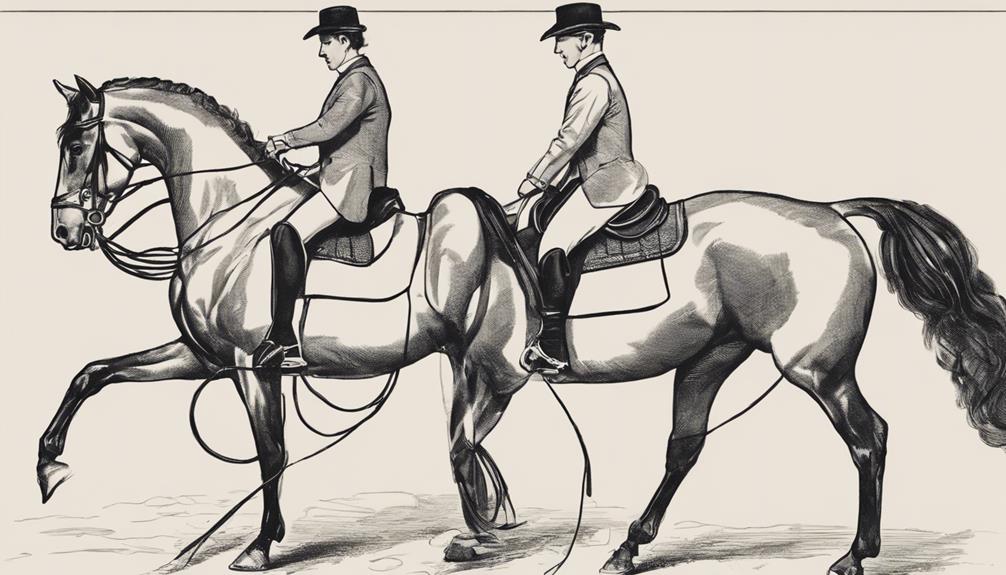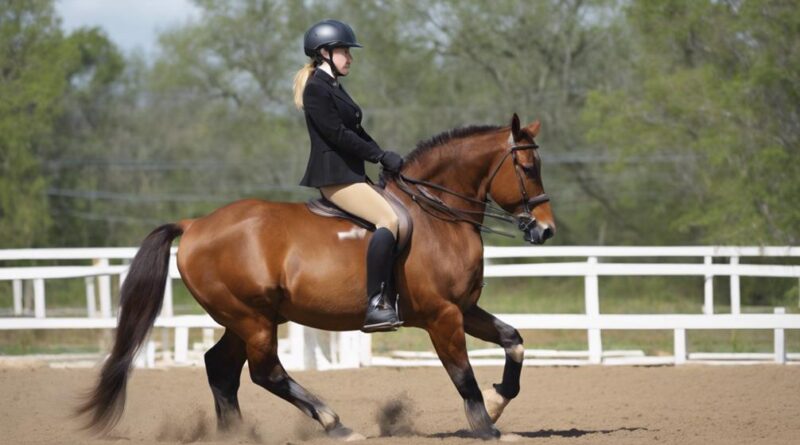7 Best Tips on Decoding Horse Behavior in Riding
Mastering the art of deciphering your horse's behavior can greatly enhance your riding experience. From subtle shifts in body language to the nuances of vocalizations, understanding these cues is crucial for effective communication with your equine partner. By grasping the seven key tips outlined, you'll be better equipped to navigate the intricacies of horse behavior in riding situations.
Explore the depths of horse psychology and unlock the secrets that will elevate your equestrian journey to a whole new level.
Understanding Horse Body Language
To understand horse body language, pay close attention to their subtle cues and movements. Horses communicate primarily through body language cues, using nonverbal signals to express their feelings and intentions. As a rider, being aware of these cues is essential for building a strong bond with your horse and ensuring effective communication during rides.
One key body language cue to watch for is ear position. A horse with its ears forward is typically alert and attentive, showing interest in its surroundings. On the other hand, ears pinned back against the head may indicate aggression or discomfort. Understanding these nuances can help you gauge your horse's mood and react accordingly.
Another important aspect of horse body language is their posture. A relaxed horse will have a lowered head, soft eyes, and a slightly arched neck. In contrast, a tense or anxious horse may hold its head high, with tense muscles and wide eyes. By observing these subtle differences, you can adjust your riding style to help your horse feel more at ease.
Recognizing Signs of Stress
Watching for subtle changes in your horse's behavior can help you recognize signs of stress during riding sessions. It's essential to pay close attention to your horse's body language and communication cues to ensure a positive experience for both of you.
- Stress Indicators: Keep an eye out for signs such as pinned ears, swishing tail, or excessive sweating. These can all indicate that your horse is feeling stressed or uncomfortable during the ride.
- Tension Signals: Notice if your horse is holding tension in its body, such as a stiff back, tight jaw, or raised head. These tension signals can be clear indicators of stress that you should address promptly.
- Communication Cues: Your horse may communicate its stress through subtle cues like changes in breathing patterns, increased restlessness, or avoidance behaviors. Understanding these communication cues can help you respond effectively to alleviate your horse's stress.
Building Trust and Communication
Developing a strong bond with your horse is key to enhancing trust and communication in your riding sessions. Trust building is a crucial aspect of this relationship. Horses are perceptive animals that respond well to consistent and patient interactions. By spending quality time with your horse, grooming, and engaging in ground activities, you establish a sense of security for them. This trust forms the foundation for effective communication during your rides.
Effective communication with your horse involves more than just verbal cues. Horses primarily communicate through body language, so it's essential to be aware of your own posture and movements. Practice clear and consistent signals to convey your intentions. Remember, horses are sensitive to subtle changes, so maintaining a calm and composed demeanor will help them feel at ease.
Incorporating groundwork exercises can further strengthen your bond and communication with your horse. These exercises not only provide mental stimulation but also establish a sense of respect and trust between you and your horse. Through groundwork, you can work on establishing boundaries and reinforcing positive behaviors, leading to a more harmonious riding experience.
Establishing Leadership in Riding
Building trust and effective communication with your horse sets the foundation for establishing leadership in riding. As you navigate the world of equestrian activities, it's crucial to establish yourself as a confident and capable leader in your horse's eyes. Here are some key points to consider when working on establishing leadership:
- Consistency is Key: Horses thrive on predictability and routine. By being consistent in your cues, commands, and expectations, you establish a sense of stability and authority that your horse will respond to positively.
- Confidence in Communication: Your horse looks to you for guidance and reassurance. By maintaining a confident posture, clear signals, and assertive yet gentle handling, you convey a sense of leadership that will earn your horse's respect.
- Setting Boundaries: Just like any relationship, it's essential to set clear boundaries with your horse. By establishing boundaries through consistent training and reinforcement, you show your horse that you're in charge and create a safe and structured environment for both of you.
Using these leadership techniques and establishing authority through trust, consistency, confidence, and boundaries, you can cultivate a strong and respectful partnership with your horse that enhances your riding experience.
Interpreting Equine Vocalizations
Understanding equine vocalizations is crucial for effective communication and connection with your horse during riding activities. Horses use vocal cues to express a range of emotions, and being able to interpret these signals will help you better understand your horse's needs and feelings.
When riding, pay attention to the different sounds your horse makes. A soft nicker or whinny can indicate a sense of contentment or excitement, showing that your horse is comfortable and enjoying the ride. On the other hand, a high-pitched squeal or prolonged neigh may signal agitation, fear, or discomfort. Understanding these vocalizations can help you adjust your riding approach accordingly.
Keep in mind that horses can also use their voices to communicate with each other while in a group or pasture. By listening to your horse's vocalizations during riding, you can gain insights into their emotions and reactions to the environment. This awareness will enable you to respond appropriately and build a stronger bond with your horse.
Reading Horse Facial Expressions
To enhance your connection with your horse during riding activities, observe and interpret the subtle cues conveyed through its facial expressions. Horses can communicate a lot through their facial expressions, giving you valuable insights into their emotions and state of mind. By learning to read these facial cues, you can better understand your horse and improve your overall communication with them.
Interpreting Emotions Through Facial Cues:
- Eyes: The eyes are a window to a horse's soul. Wide eyes may indicate fear or alertness, while half-closed eyes often signal relaxation and contentment.
- Nostrils: Pay attention to the flare of your horse's nostrils. Flared nostrils can indicate excitement, exertion, or stress, while relaxed nostrils suggest calmness.
- Mouth and Lips: A tense mouth with tight lips may signify anxiety or discomfort, whereas a relaxed, slightly open mouth indicates a more content and at ease state.
Responding to Behavioral Cues

Observe your horse's body language closely to effectively respond to its behavioral cues while riding. Reacting quickly to horse signals is crucial in maintaining a harmonious interaction. Pay attention to signs such as pinned ears, tail swishing, or tension in the body, as these could indicate discomfort or unease. By being alert and responsive, you can address issues promptly and prevent escalation.
When your horse displays behavioral cues, adjust your riding accordingly. For example, if your horse starts to speed up unexpectedly, check your own posture and rein contact to ensure you aren't inadvertently signaling for a faster pace. By making immediate changes to your riding, you can communicate to your horse that you have noticed its cues and are taking action to address them. This helps build trust and understanding between you and your horse.
Remember that every horse is different, so it's essential to familiarize yourself with your horse's individual cues and responses. Practice interpreting these signals during training sessions and rides to become more attuned to your horse's needs. By consistently adapting your riding to match your horse's behavioral cues, you can create a more effective and enjoyable riding experience for both of you.
Improving Rider-Horse Bond
Strengthen your connection with your horse by actively engaging in bonding activities both on and off the saddle. Building a strong bond with your horse is essential for a successful and enjoyable riding experience. Here are some key strategies to enhance the rider-horse bond:
- Trust exercises: Trust is the foundation of any relationship, including the one you have with your horse. Engage in trust-building exercises such as ground work, where you work with your horse from the ground to establish mutual trust and respect. This can include activities like leading your horse through obstacles or practicing liberty work in a round pen.
- Bonding strategies: Spend quality time with your horse outside of riding sessions. Grooming, hand grazing, or simply spending time in the pasture together can help strengthen the bond between you and your horse. Building a relationship based on trust and companionship will lead to better communication and cooperation when riding.
- Communication: Pay attention to your horse's body language and cues. Understanding how your horse communicates will help you build a stronger connection. Practice clear and consistent communication both on the ground and while riding to foster trust and understanding between you and your horse.
Frequently Asked Questions
How Can a Rider Address Specific Behavioral Issues in Their Horse, Such as Bucking or Bolting?
When your horse displays behaviors like bucking or bolting, start by addressing them through groundwork exercises.
Use positive reinforcement to encourage desired behaviors.
If the issues persist, consider behavioral training. Seeking professional guidance from a qualified trainer can also provide valuable insights.
What Are Some Common Mistakes Riders Make That Can Negatively Impact Their Horse's Behavior?
When riding, common mistakes can negatively affect your horse's behavior. Inconsistency in training techniques can confuse your horse, leading to behavioral issues. Using positive reinforcement and clear body language is key.
Avoid sending mixed signals by staying consistent in your commands. By understanding how your actions impact your horse, you can build a better relationship and improve behavior in the saddle.
How Can a Rider Differentiate Between a Horse Being Stubborn and a Horse Experiencing Physical Discomfort?
When your horse acts stubborn, it might be pain. Look for pain indicators like tense muscles or pinned ears. Watch for subtle signs. Use gentle training techniques. Understand signals your horse gives. Building trust is key.
If behavior changes suddenly, consider discomfort. Take time to observe and communicate with your horse. Address any physical issues promptly. It's crucial to differentiate between stubbornness and pain for your horse's well-being.
Are There Any Tools or Aids That Can Help Improve Communication Between a Rider and Their Horse?
To enhance communication with your horse, training aids like lunging reins and side reins can assist in developing a better connection. Pay attention to your body language as it speaks volumes to your horse.
Reinforcement techniques and trust-building exercises such as positive reinforcement and consistent cues can strengthen your bond. Remember, clear and consistent signals paired with understanding your horse's responses are key to effective communication in riding.
How Can a Rider Adjust Their Riding Style to Better Accommodate Their Horse's Individual Behavior Traits?
To adjust your riding style for your horse's behavior traits, focus on bonding techniques and training methods. Use riding adjustments and communication cues to better connect with your horse.
Pay attention to their body language and responses to tailor your approach. Remember that each horse is unique, so be patient and observant to find what works best for them.
Building a strong bond through understanding and adapting will enhance your riding experience.
Conclusion
Now that you have learned how to decode horse behavior in riding, remember to always pay attention to your horse's body language, vocalizations, and facial expressions.
Building trust and communication, establishing leadership, and responding to behavioral cues are key in developing a strong bond with your horse.
By understanding and interpreting these signals, you can improve your riding experience and create a harmonious partnership with your equine companion.
Keep practicing and enjoy the journey!
